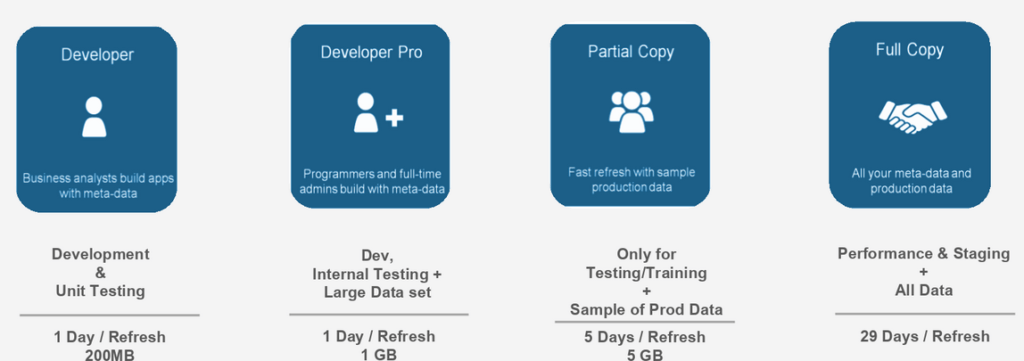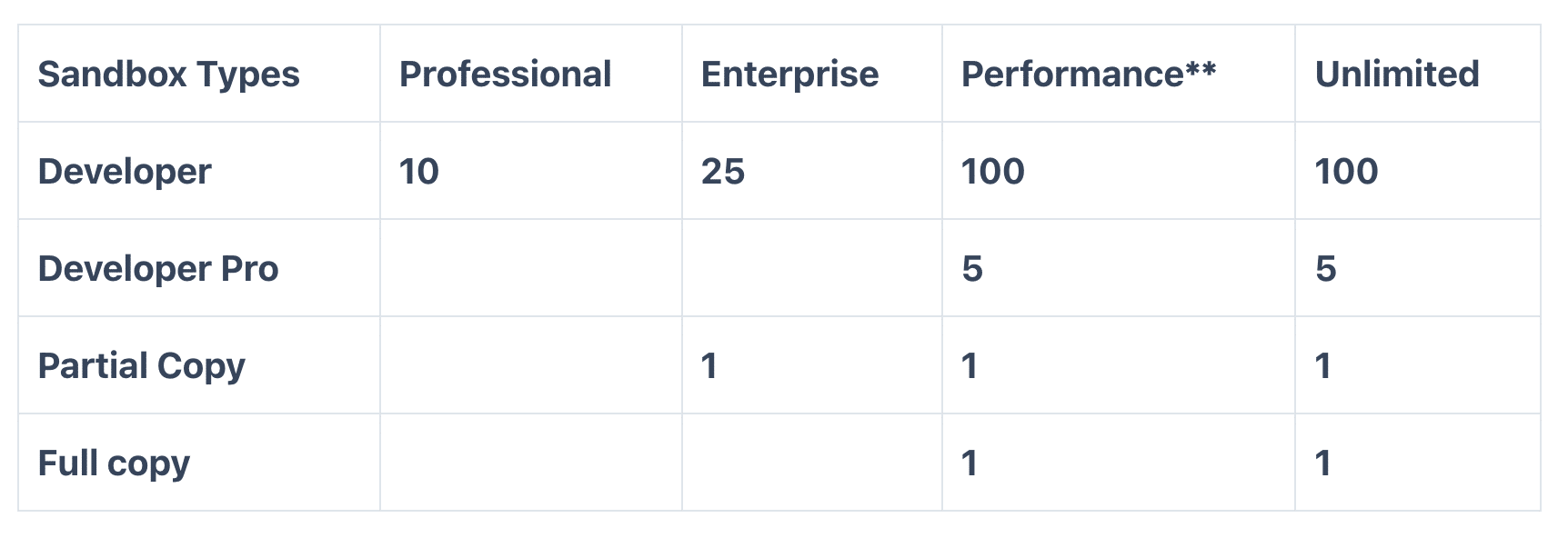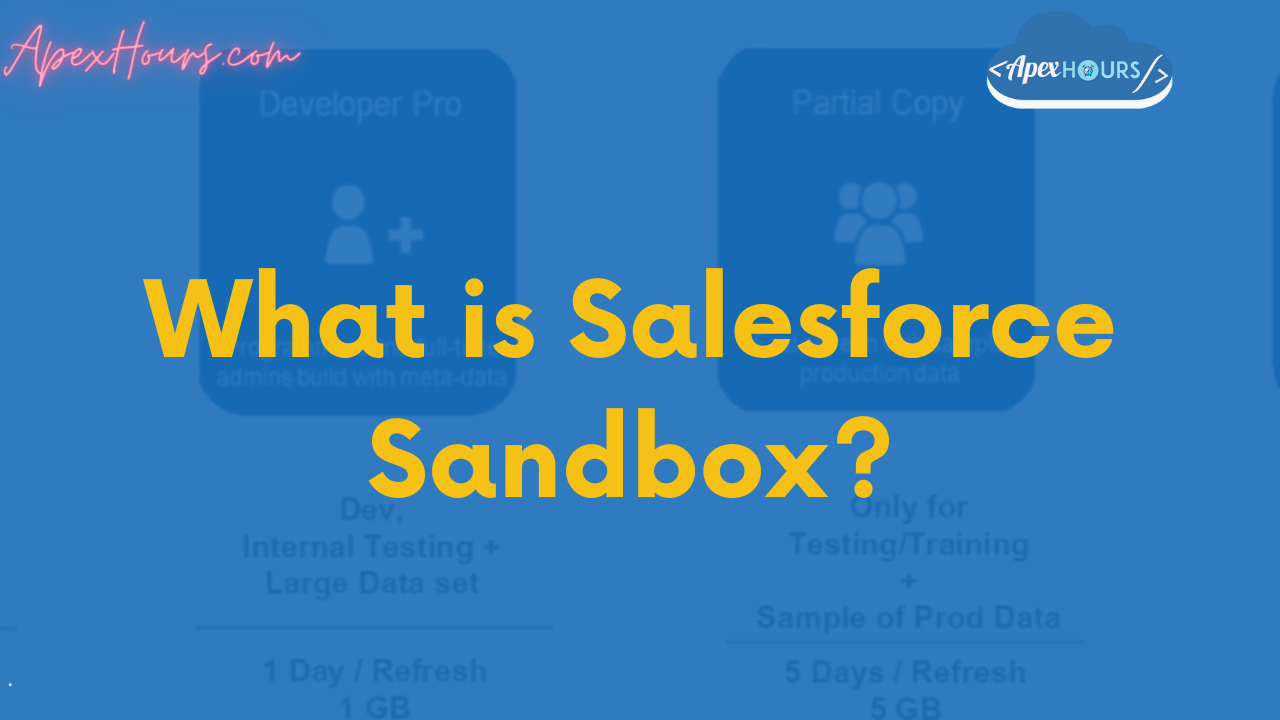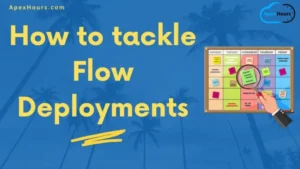In this post, we will discuss a sandbox in Salesforce and the different types of sandboxes available. We will also learn when to use which Salesforce sandbox. The benefit of a Sandbox is that you can do anything you like there without any risk of harming the configuration or data contained in your Production environment.
What is Sandbox in Salesforce?
A Salesforce sandbox is an isolated copy of your organization’s production environment that is used for development and testing purposes. Your production environment has your live data and active users logging in. A Salesforce sandbox will always include a copy of your production organization’s metadata (objects, fields, page layouts, etc.) but it may or may not include a copy of your production organization’s data (account records, contact records, files, etc.).
- Copy of your Salesforce Org/Production as a separate environment
- Development, Testing, and Training
Types of Sandbox in Salesforce
There are 4 types of Salesforce sandbox environments.
- Developer Sandbox
- Developer Pro Sandbox
- Partial Copy
- Full Sandbox
Different Sandbox Types in Salesforce
Let’s see the difference between all of them.

1. Developer Sandbox
Developer sandboxes are special configuration sandboxes intended for coding and testing by a single developer. Just like Developer Pro sandboxes, Developer sandboxes copy all application and configuration information to the sandbox. Developer sandboxes are limited to 200 MB of test or sample data, which is enough for many developments and testing tasks. You can refresh a Developer sandbox once per day.
- REFRESH LIMIT- Daily
- DATA LIMIT- 200MB
2. Developer Pro Sandbox
The main difference between this and Developer is the amount of data that can be stored. It also grabs some product data from production. If those two things are important, use this one. Developer Pro sandboxes copy all of your production organization’s reports, dashboards, price books, products, apps, and customizations under Setup but exclude all of your organization’s standard and custom object records, documents, and attachments. It can only include up to 1 GB of data. You can refresh a Developer Pro sandbox once per day.
- REFRESH LIMIT- Daily
- DATA LIMIT- 1GB
3. Partial Copy
What is partial copy sandbox in Salesforce? Partial Data sandboxes include all of your organization’s metadata and add a selected amount of your production organization’s data that you define using a sandbox template. A Partial Data sandbox is a Developer sandbox plus the data you define in a sandbox template. It includes the reports, dashboards, price books, products, apps, and customizations under Setup (including all of your metadata). Additionally, as defined by your sandbox template, Partial Data sandboxes can include your organization’s standard and custom object records, documents, and attachments up to 5 GB of data and a maximum of 10,000 records per selected object. A Partial Data sandbox is smaller than a Full sandbox and has a shorter refresh interval. You can refresh a Partial Data sandbox every 5 days.
- REFRESH LIMIT- 5 Days
- DATA LIMIT- 5GB
4. Full Copy Sandbox
Full sandboxes copy your entire production organization and all its data, including standard and custom object records, documents, and attachments. You can refresh a Full sandbox every 29 days.Sandbox templates allow you to pick specific objects and data to copy to your sandbox, so you can control the size and content of each sandbox. Sandbox templates are only available for Partial Data or Full sandboxes.
- REFRESH LIMIT- 29 Days
- DATA LIMIT- Same as Production
Sandbox Allocations
Each type has different features to support the activities it’s designed for
| Sandbox Types | Professional | Enterprise | Performance** | Unlimited |
| Developer | 10 | 25 | 100 | 100 |
| Developer Pro | 5 | 5 | ||
| Partial Copy | 1 | 1 | 1 | |
| Full copy | 1 | 1 |
How to create or edit Sandbox Templates
Sandboxes can easily be created from your production org by headings into the Setup menu in the back-end of Salesforce, and typing in “Sandboxes” into the quick search.
- From Setup, enter Sandboxes in the Quick Find box, select Sandboxes, then click the Sandbox Templates tab.
- Click New Sandbox Template or click Edit next to an existing template you want to modify.
- Enter a name and description for the sandbox template.
- To add objects to the template, select the checkbox for each object you want from the available Objects list.The Object Details section shows you the objects to be added automatically with the one you’ve selected.
- To remove objects from the template, deselect the checkbox for the object in the available Objects list.If you remove an object you previously selected, dependent objects you didn’t explicitly select are removed. If you attempt to remove an object with dependent objects, you receive a warning requesting confirmation of the removal. After you confirm your choice, those objects are also removed.
- Click Save.
When to use which Sandbox in Salesforce?
Learn more about when you should which type of Sandbox on our Salesforce Testing post. Also Check sandbox design strategies. Where you will learn about how to make environment strategies for different organization base on branching strategies for Salesforce.
| Use Case | Developer | Developer Pro | Partial Copy | Full |
| Build | ● | ● | ||
| Proof of Concept | ● | ● | ||
| QA | ● | ● | ● | |
| Integration Testing | ● | ● | ● | ● |
| Batch Data Testing | ● | ● | ||
| Training | ● | ● | ||
| User Acceptance Testing | ● | ● | ||
| Performance or Load Testing | ● | |||
| Staging | ● |
Let’s have a look at when we should which sandbox in Salesforce.
FAQ’s
Only few sandboxes come free with different organizations.
There are 4 types of different salesforce sandboxes are in Salesforce.
Summary
Salesforce sandbox is a copy of your production org, which contains all the configuration, customization, app, and code. Some sandboxes contain the some or call database of a sandbox type. I hope this session helped you to understand what Salesforce Sandbox is and the different types of Sandboxes in Salesforce.






Thank you for sharing the information. It was very help for preparing for my PD1 exam